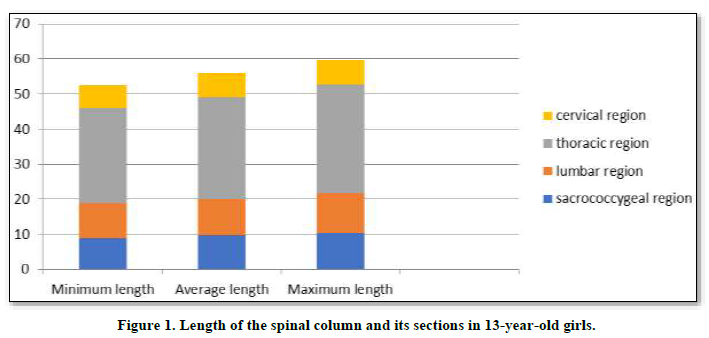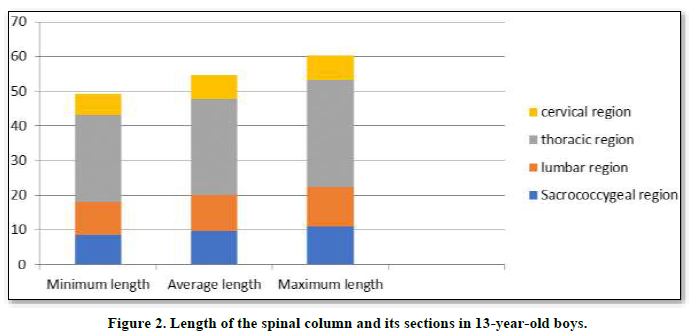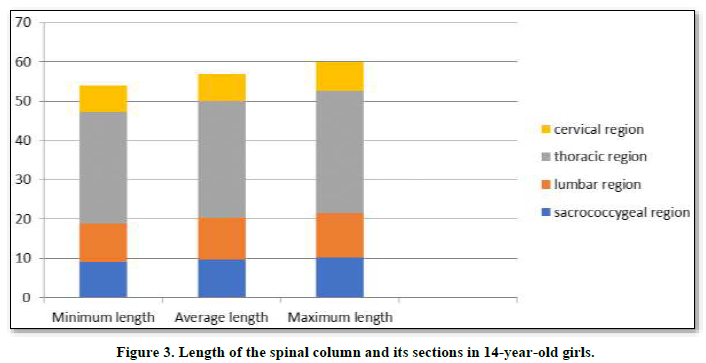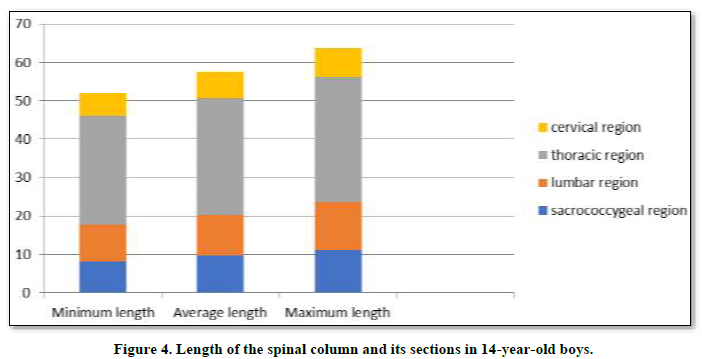186
Views & Citations10
Likes & Shares
Modern socio-economic conditions, despite the implementation of measures to modernize the healthcare system, have an adverse impact on the health of some of the population, primarily children, therefore the primary task of healthcare institutions is the development of therapeutic and recreational activities aimed at positive changes in the health indicators of children and adolescents (Baranova, 2006; Bespalova, 2012; Galkina, 2008; Efremova, 2002).
We have to admit that anthropometric studies of the spine in children are very few (Navruzov, Ruziboev, & Turamuratova 2019; Labzin, Rodionov, 2006; Mirbabaeva, 2004). Only one study describes the characteristics of the structure of the cervical vertebrae (Labzin, Rodionov, 2006). A number of authors conducted anthropometric studies without studying the spine (Galkina, 2008; Labzin, Rodionov, 2006; Mirbabaeva, 2004). They paid attention to changes in height, body weight, chest circumference, length of the thigh, lower leg, and shape of the back, but no information was provided from these works about the nature of changes in the spine itself.
PURPOSE OF THE STUDY
Study of anthropometric indicators of various parts of the spinal column in adolescents 13-14 years old living in the regions of the Southern Aral Sea region.
MATERIAL AND METHODS
The material for the study was practically healthy children 13-14 years old - students of school No. 4 in the Shavat district. A total of 107 girls and 118 boys were examined in family clinic No. 52 of the Shavat district. The data obtained was subjected to statistical processing on a Pentium IV computer using the Microsoft office Excel 2010 software package, including the use of built-in statistical processing functions.
RESULTS AND DISCUSSION
Growth processes of the spinal column have significant age and individual differences. During the prepubertal period, growth is observed intensive development of the spine. In the postnatal period, during the first two years, maximum annual increases in the spinal column are observed. Length of the spinal column of a newborn the child is 40% of the length of his body. In the first year of life, the lumbar region grows faster, the cervical, thoracic and sacral regions grow somewhat slower departments. The coccygeal region grows the slowest. The length of the spine increases especially sharply in during the 1st and 2nd years of life, then the growth of the spine slows down. An increase in the rate of growth of the spine is observed at 7-9 years of age (more in girls than in boys). The next period of active growth of the spine is observed during puberty in children 13-14 years old, when a significant increase in the length of the body is noted (Navruzov, Ruziboev, & Turamuratova 2019; Baranov, Kuchma, & Skoblina, 2008; Baranova, 2006; Bespalova, 2012; Galkina, 2008; Efremova, 2002; Labzin, Rodionov, 2006; Mirbabaeva, 2004). Studies have shown that the total length of the spinal column of 13-year-old girls ranged from 50.53 to 59.89 cm, with an average of 54.50 ± 2.72 cm. The length of the cervical region varied from 6.32 to 7.20 cm, in on average 6.75±0.33 cm. The length of the thoracic region ranged from 27.22 to 31.10 cm, with an average of 29.16 ± 1.54 cm. Lumbar spinal column length ranged from 9.89 to 11.24 cm, with an average of 10.42±0.52 cm. The length of the sacrococcygeal region varied from 8.92 to 10.32 cm, with an average of 9.60±0.33 cm (Figure 1).
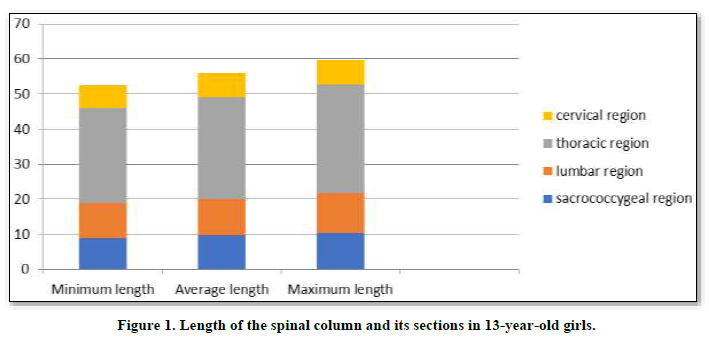
Total length of the spinal column of 13-year old boys ranged from 51.12 to 58.54 cm, on average 54.17±2.78 cm. The length of the cervical region varied from 6.15 to 7.17 cm, average 6.65±0.30 cm. The length of the thoracic region ranged from 24.99 to 30.76 cm, on average 27.87±1.55 cm. The length of the lumbar spine ranged from 9.45 to 11.45 cm, with an average of 10.28 ± 0.51 cm. The length of the sacrococcygeal region varied from 8.59 to 11.00 cm, with an average of 9.69±0.42 cm (Figure 2).
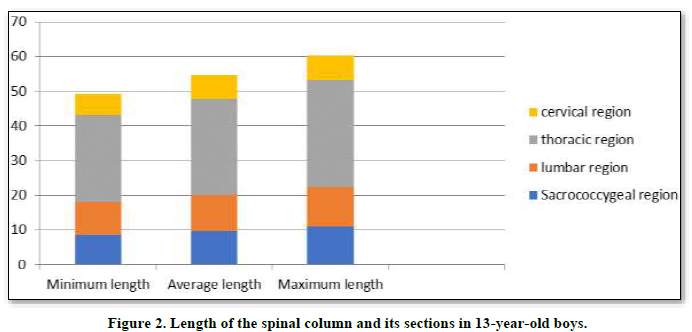
The total length of the spinal column of 14-year-old girls ranged from 53.9 to 59.89 cm, with an average of 56.85 ± 2.72 cm. The length of the cervical region varied from 6.6 to 7.2 cm, average 6.95±0.23 cm.
The length of the thoracic region ranged from 28.42 to 31.2 cm, on average 29.8±1.54 cm. The length of the lumbar spine ranged from 9.8 to 11.2 cm, with an average of 10.5 ± 0.52 cm. The length of the sacrococcygeal region varied from 9.1 to 10.32 cm, with an average of 9.75 ± 0.33 cm (Figure 3).
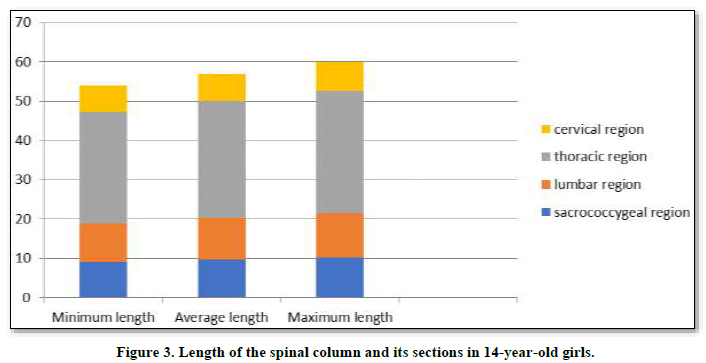
The total length of the spinal column of 14-year-old boys ranged from 51.62 to 63.3 cm, with an average of 57.45 ± 2.18 cm. The length of the cervical region varied from 6.0 to 7.5 cm, average 6.75±0.30 cm.
The length of the thoracic region ranged from 28.4 to 32.6 cm, with an average of 30.55 ± 1.1 cm.
The length of the lumbar spine ranged from 9.5 to 12.5 cm, with an average of 10.55±0.52 cm. The length of the sacrococcygeal region varied from 8.2 to 11.1 cm, with an average of 9.65±0.22 cm (Figure 4).
CONCLUSIONS
Since the spine is formed from early childhood, it is logical to begin the study of morphological changes in the spine in children. The growth processes of the spinal column have significant age-related and individual differences, especially in children 13-14 years old. This is due to the onset of puberty in the physical development of the child.
The increase in the length of the spinal column in female children aged 14 years in the cervical and sacrococcygeal regions occurs more intensely compared to the thoracic and lumbar regions. The increase in the length of the spinal column in male children aged 14 years in the lumbar and thoracic region occurs more intensely compared to the cervical and sacrococcygeal region.
By the beginning of the period before puberty, growth the spinal column slows down. A new acceleration of its growth is observed in boys by the age of 14, in girls by the age of 13.
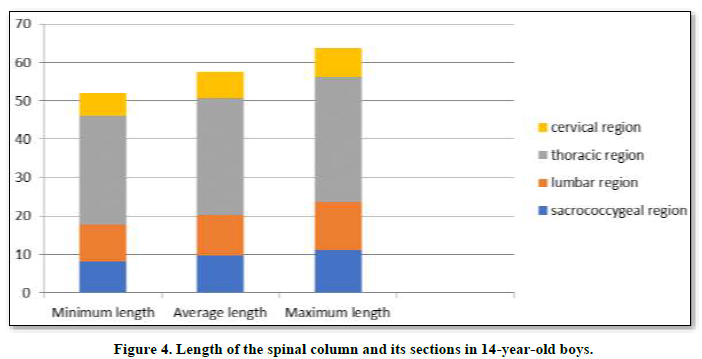
- Navruzov D.K., Ruziboev R. Yu., &Turamuratova M.B. (2019). Age related features of anthropometric indicators of various departments of the spinal column in children 13 years old living in the south Аral sea HERALD TMA. Tashkent 2019 № 4, 107-109. Available online at: www.tma-journals.uz
- Baranov A.A., Kuchma V.R., & Skoblina N.A. (2008). Physical development of children and adolescents at the turn of the millennium M Publisher Scientific Center for Children's Health of the Russian Academy of Medical Sciences. 2-6.
- Baranova A.A. (2006). Physiology of growth and development of children and adolescents a practical guide M. Publishing house GEOTAR Media. 432.
- Bespalova T.V. (2012). Conceptual approach to the formation and assessment of the health of children and adolescents living in different climatic and geographical conditions Scientific Medical Bulletin. Khanty Mansiysk.27-33.5.
- Galkina T.N (2008). Anthropometric and somatotypological characteristics of adolescents in the Penza region: abstract of thesis. Dis cand honey Sciences 21.
- Efremova V.P (2002). Features of the physical status of young men in Eastern Siberia Morphology St Petersburg Aesculapius.52.
- Navruzov D.K. (2022). Features of Anthropometric Parameters of the Vertebral Column in Boys Aged 1-16 Years Living in Rural and Urban Conditions of the Khorezm Region Materials of the scientific-practical conference of morphologists of the Republic of Uzbekistan. American Journal of Medicine and Medical Sciences 12,706-708.
- Kuchma V.R. (2004). Hygiene of children and adolescent’s textbook. for medical students’ universities M Medicine. 382.
- Labzin V.I., Rodionov A.A. (2006) Individual and typological features of the structure of the human cervical spine. Far Eastern Medical Journal, 4, 85-87.
- Mirbabaeva S. A. (2004). Age-related features of the growth of anthropometric body parameters in children 7-12 years of age in low-mountain conditions. Dis. Cand. Honey Sciences Ufa, 23.

